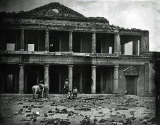 |
| HOME | FORUM | REGISTER | LOGIN | HOAXIPEDIA | TOP 100 APRIL FOOLS | COLLEGE PRANKS | ABOUT THE CURATOR |
| A HISTORY OF HOAXES | HOAX WEBSITES | HOAX PHOTO TESTS | GULLIBILITY TESTS | TALL-TALE CREATURES | CONTACT |
Techniques of Fakery
There are six basic techniques of faking a photo, none of which are mutually exclusive.
1: Inserting details. This includes placing an element from one photo into another to create a composite image, reproducing a detail of the photo by cloning it, superimposing an image onto another, or drawing-in details.
2: Deleting details. This is usually done by extending background elements over the unwanted detail. Or one can crop out the unwanted detail.
3: Manipulating elements within the photo. For instance, one can adjust the color, resize details, or rotate or move details.
4: falsifying the caption. (In a sense, every fake photo has been falsely captioned.)
5: Staging the scene. This is considered fakery particularly when it occurs in photojournalism. Varieties of staging a scene include using models and cutouts and inserting a prop into the scene.
6: Taking a photo at a trick angle. The most common example of this is the use of forced perspective.
Themes
Time Periods
There are six basic techniques of faking a photo, none of which are mutually exclusive.
1: Inserting details. This includes placing an element from one photo into another to create a composite image, reproducing a detail of the photo by cloning it, superimposing an image onto another, or drawing-in details.
2: Deleting details. This is usually done by extending background elements over the unwanted detail. Or one can crop out the unwanted detail.
3: Manipulating elements within the photo. For instance, one can adjust the color, resize details, or rotate or move details.
4: falsifying the caption. (In a sense, every fake photo has been falsely captioned.)
5: Staging the scene. This is considered fakery particularly when it occurs in photojournalism. Varieties of staging a scene include using models and cutouts and inserting a prop into the scene.
6: Taking a photo at a trick angle. The most common example of this is the use of forced perspective.
Themes
Time Periods
Thumbnail Gallery: Present-1840
The Hoax Photo Database catalogs examples of photo fakery throughout the history of photography. Included in the database are photos that are "real," but which have been suspected of being fake, as well as images whose veracity remains undetermined. The images are listed here in reverse-chronological order (you can also view them in chronological order, 1840 to the present). They are categorized by theme, technique of fakery, and time period.
Other Viewing Options: Full Text Mode: Present-1840 or 1840-Present



